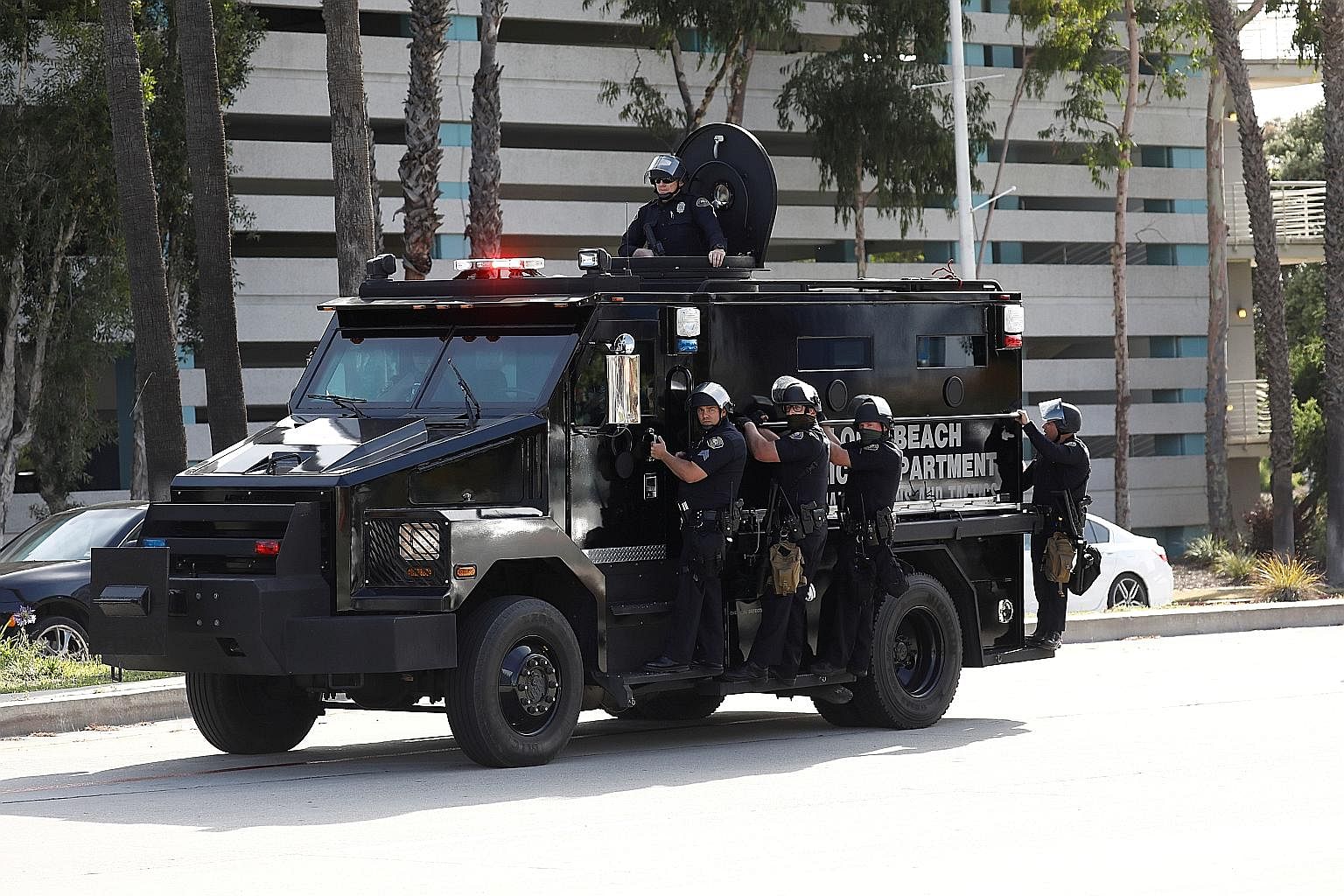The militarisation of US police forces
Sign up now: Get ST's newsletters delivered to your inbox

Californian police in riot gear on an armoured vehicle during unrest across the US following the death of Mr George Floyd last month.
PHOTO: REUTERS
Charissa Yong US Correspondent In Washington, Charissa Yong
Follow topic:
In the wake of Mr George Floyd's death, Americans were taken aback by armour-plated vehicles designed to withstand landmines rolling down the main streets of their cities, as police officers decked out in full riot gear kept an eye on, and sometimes clashed with, protesters.
The scenes once again shone a spotlight on how much civilian cops in the US are becoming like the military, from equipment to tactics to culture.
This militarisation has its roots in the 1990s, taking off in earnest when the Clinton administration's 1033 programme started allowing civilian police to get surplus military equipment for almost free.
The war on terror stepped up these transfers. Local law enforcement agencies got billions in federal grants to buy military equipment, and as the US began to withdraw its troops from Iraq and Afghanistan, local police got even more military hand-me-downs.
As of this year, US$7.4 billion (S$10.3 billion) worth of military equipment had been transferred to local law enforcement agencies, ranging from mundane items like first aid kits and flashlights to tactical vehicles and small arms.
After the Ferguson uprising in 2014, when police received flak for their heavy-handed response to those protesting against the fatal shooting of black teenager Michael Brown by a white police officer, the Obama administration rolled out new limits to the programme.
Police forces were banned from acquiring equipment like grenade launchers and bayonets, and had to justify the use of drones, armoured vehicles and other riot gear, as well as ensure officers were trained to use them. These restrictions were reversed by the Trump administration in 2017.
Research shows that when cops are equipped like soldiers, they are also more likely to act like soldiers.
In a 2017 paper - Militarisation And Police Violence: The Case Of The 1033 Programme - researchers showed that when cops get more military weapons, vehicles and tools, they use more military language, create elite units like SWAT teams, and become more likely to jump into high-risk situations.
"Militarisation makes every problem - even a car of teenagers driving away from a party - look like a nail that should be hit with an AR-15 hammer," they wrote.
The more militarised law enforcement agencies were, the more civilians were killed each year by the police, the researchers found.
The American Civil Liberties Union, in a 2014 report, highlighted military-style training for cops which "encourages them to adopt a 'warrior' mentality and think of the people they are supposed to serve as enemies".
Minorities suffer disproportionately from heavily-armed police primed to resort to violence. Mapping Police Violence, a research and advocacy group, has found that a black person is 2½ times more likely to be killed by a cop than a white person.
Now, in what the White House calls an extreme swing to the left that will lead to chaos, crime and anarchy, calls are mounting to defund the police.
Most proponents of the controversial proposal say they are not asking for police forces to be totally abolished, but for funds in their budgets to be redirected to education, healthcare and other community programmes in the neighbourhoods they serve.
They point to how police budgets have crept up over the years even as cities grew safer. A New York Times analysis of 150 large cities found police budgets' share of city spending rose by 1.2 percentage points since the late 1970s, to 7.8 per cent.
New York City spends 6 per cent of its budget, or about US$6 billion, on its cops - a sum which advocacy group Public Citizen said would make it the 33rd largest military spender in the world.
Progressive Democrat lawmaker Alexandria Ocasio-Cortez wrote on Twitter: "It truly boggles my mind how anyone can see a $6 billion policing budget in ONE city alone - which is more than we spend on health, youth, housing, and homelessness services here combined - and say, 'You know what will fix police brutality? More money'."
But at least one aspect of calls for police reform has drawn support from both sides of the aisle, that is appeals to demilitarise America's police, which have grown with the George Floyd protests.
Republican Senator Rand Paul of Kentucky and Democratic Senator Brian Schatz of Hawaii have both said they supported ending the 1033 programme.
"I don't think we need bayonets and tanks in our streets," said Mr Paul in a discussion with Kentucky activists last week. "I think it sends a wrong message and it's not really what our country's about."

